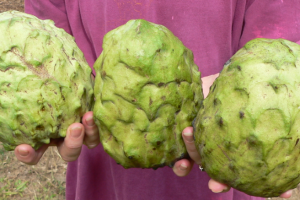Annona cherimola x Annona squamosa
Atemoya, custard apple
Origin
Native to the American tropics and sub-tropics and now distributed worldwide in these climates.
Climate
It is a sub-tropical species and can withstand only very light frosts when mature; young trees may be killed. In too warm sub-tropical climates it may grow vigorously but produce few fruit. Ideal temperatures and humidity during flowering are 22-28°C and 60-95%. Excessively low and high temperatures retard fruit maturation and cause premature ripening respectively.
Plant Description
They are semi-deciduous plants, 3-8m tall with drooping branches and a short trunk, dormant in late winter and early spring. Vegetative buds are sub-petiolar, so leaf abscission has to occur before any growth flushes can develop. Leaves are alternate, elliptical, leathery and 10-15cm long.
Relatives
Annonaceae Family. There are more than 100 species in the genus, with atemoya, sugar apple and cherimoya being the most important. Sugar apple has the largest production worldwide whereas atemoya is dominant in Australia.
Soils
A wide range of soils is acceptable, from sandy to sandy loams providing they are well-drained and have a pH of about 6.
Propagation
Normally by grafting but cuttings can also be used. Cherimoya is usually the rootstock of choice with a balanced mix of favourable attributes such as compatibility, vigour and disease resistance.
Cultivars
The main commercial cv in Australia is African Pride which has a degree of self-fertilization. Pink’s Mammoth is a larger sweeter fruit but needs hand pollination for good yields. Others include Hillary White, Gefner, Island Gem, KJ Pinks (aka Paxton Prolific) and Maroochy Gold.
Flowering and Pollination
Hermaphrodite triangular yellow-green flowers begin to appear in early summer and can extend for 3-6 months. They are axillary, solitary or in clusters of 2-3, on long pedicels up to 6cm long, and have a cone-shaped receptacle with numerous carpels surrounded by a collar-shaped androecium in the basal part. The receptacle is surrounded by 3-4 sepals and 6-8 fleshy petals in 2 whorls. Carpels are sessile with 1 ovule in each ovary. Flowers exhibit protogynous dichogamy with stigmas normally being receptive in the morning and anthers releasing pollen in the afternoon.
This seems to be the main factor limiting fruit set (only 2% of flowers), but there can be some overlap with temperatures >32°C. Beetles are the main pollinators; wind and self-pollination account for only 1-2%. It is frequently necessary to hand pollinate for good yields. Naturally pollinated fruit set with the KJ Pinks cv often requires thinning.
Cultivation
They should be planted in full sun. The goal with young plants for the first 3 years is to foster maximum vegetative growth and thereafter bring the plant into bearing. With mature plants, minimising water during the flowering period increases reproductive growth rather than vegetative, but once fruit have set, proper development requires adequate moisture and nutrients. In some locations they may develop zinc deficiency. NPK plus trace elements should be given in split amounts during the 3 warmer seasons, increasing with tree size. Mulching is beneficial.
Wind Tolerance
Trees are susceptible to wind damage and there may also be considerable fruit rub in exposed areas.
Pruning
Initial pruning aims to establish a vase shape. A healthy mature tree can have a dense canopy resulting in poor light penetration throughout the tree, so pruning needs to address this problem.
The Fruit
The green fruit is a pseudocarp, 300g-1kg, formed by the fusion of the receptacle and carpels into a fleshy mass. Shape is variably ovoid with numerous fleshy bumps; irregularity is the result of incomplete pollination. The white flesh, easily separated from the many black seeds, has a reasonable level of Mg, and vitamin C equivalent to citrus.
Fruit Production and Harvesting
Grafted plants may take 3-4 years to bear and well-managed mature trees can produce hundreds of fruit pa. Fruit mature over several months, of benefit to the home grower but not for the commercial. The fruit skin remains green when mature, but they can be clipped from the tree when the skin changes to a dull yellowish-green. Mature fruit then ripen and soften in 3-7 days at ambient temperature. Fruit stored in a refrigerator (5°C) for more than a few days will suffer chilling injury.
Fruit Uses
Usually eaten fresh by scooping out the flesh. It is popular for fruit combinations and ice cream. If blending the flesh, make sure all seeds are removed as they are toxic.
Pests and Diseases
These include scale, mealy bug, fruit flies, black canker which can mummify the fruit, various fruit and root rots and bacterial wilt.
Comments
Most people rate custard apples as one of the most delicious fruits, despite the sometimes numerous seeds. They grow and fruit well in our sub-tropical climate. They can be grown in large pots and will produce fruit.


